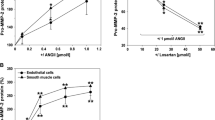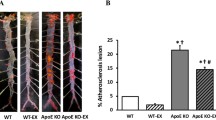Abstract
The development of hypercholesterolemia is a multifactorial process in which elevated plasma cholesterol levels play a central role. This study analyzed the variability of the expression and activity of myosin light chain kinase (MLCK) and endothelial permeability in the artery wall of rabbits after feeding the animals with a normal or a high-cholesterol diet. Hypercholesterolemia was induced by a high-cholesterol diet for 4 weeks. Aortas were removed and analyzed for endothelial permeability and MLCK expression. Samples of the arterial media were analyzed for MLCK activity and expression. A selective MLCK inhibitor 1-(5-iodonaphthalene-1-sulfonyl)-1H-hexahydro-1,4-diazepine hydrochloride (ML7) were used in hypercholesterolemia rabbit (1 mg/kg body weight). The aortas of high-cholesterol diet rabbits showed an increase in MLCK expression and activity (nearly threefold compare with control) as well as endothelial permeability. ML7 inhibit MLC phosphorylation and MLCK activity (nearly twofold compare with control) and endothelial permeability stimulated by cholesterol. These results indicate for the first time that hypercholesterolemia may be associated with MLCK expression and activity through which endothelial permeability is increased.







Similar content being viewed by others
References
Lee WC, Chao WT, Yang VC (2001) Effects of high-cholesterol diet on the interendothelial clefts and the associated junctional complexes in rat aorta. Atherosclerosis 155(2):307–312
Ross R (1993) The pathogenesis of atherosclerosis: a perspective for the 1990s. Nature 362:801–809
Schaphorst KL, Pavalko FM, Patterson CE, Garcia JG (1997) Thrombin-mediated focal adhesion plaque reorganization in endothelium: role of protein phosphorylation. Am J Respir Cell Mol Biol 17:443–455
Lum H, Malik AB (1994) Regulation of vascular endothelial barrier function. Am J Physiol 267:L223–L241
Garcia JG, Schaphorst KL (1995) Regulation of endothelial cell gap formation and paracellular permeability. J Investig Med 43:117–126
Turner JR, Angle JM, Black ED, Joyal JL, Sacks DB, Madara JL (1999) PKC-dependent regulation of transepithelial resistance: roles of MLC and MLC kinase. Am J Physiol 277:C554–C562
Wysolmerski RB, Lagunoff D (1990) Involvement of myosin light-chain kinase in endothelial cell retraction. Proc Natl Acad Sci 87:16–20
Huang Q, Xu W, Ustinova E, Wu M, Childs E, Hunter F, Yuan S (2003) Myosin light chain kinase-dependent microvascular hyperpermeability in thermal injury. Shock 20:363–368
Goeckeler ZM, Wysolmerski RB (1995) Myosin light chain kinase-regulated endothelial cell contraction: the relationship between isometric tension, actin polymerization, and myosin phosphorylation. J Cell Biol 130:613–627
Garcia JG, Davis HW, Patterson CE (1995) Regulation of endothelial cell gap formation and barrier dysfunction: role of myosin light chain phosphorylation. J Cell Physiol 163:510–522
Isotani E, Zhi G, Lau KS, Huang J, Mizuno Y, Persechini A, Geguchadze R, Kamm KE, Stull JT (2004) Real-time evaluation of myosin light chain kinase activation in smooth muscle tissues from a transgenic calmodulin-biosensor mouse. Proc Natl Acad Sci 101:6279–6284
Smith L, Su X, Lin P, Zhi G, Stull JT (1999) Identification of a novel actin binding motif in smooth muscle myosin light chain kinase. J Biol Chem 274:29433–29438
Sheldon R, Moy A, Lindsley K, Shasby S, Shasby DM (1993) Role of myosin light chain phosphorylation in endothelial cell retraction. Am J Physiol Lung Cell Mol Physiol 265:L606–L612
Tinsley JH, Teasdale NR, Yuan SY (2004) Myosin light chain phosphorylation and pulmonary endothelial cell hyperpermeability in burns. Am J Physiol Lung Cell Mol Physiol 286:L841–L847
Tinsley JH, De Lanerolle P, Wilson E, Ma W, Yuan SY (2000) Myosin light chain kinase transference induces myosin light chain activation and endothelial hyperpermeability. Am J Physiol 279:C1285–C1289
Yuan Y, Huang Q, Wu HM (1997) Myosin light chain phosphorylation: modulation of basal and protein kinase-stimulated microvascular permeability. Am J Physiol 272:H1437–H1443
Yuan SY, Wu MH, Ustinova EE, Guo M, Tinsley JH, De Lanerolle P, Xu W (2002) Myosin light chain phosphorylation in neutrophil-stimulated coronary microvascular leakage. Circ Res 90:1214–1221
Vasile E, Antohe F, Simionescu M, Simionescu N (1989) Transportpathways of beta-VLDL by aortic endothelium of normal and hypercholesterolemic rabbits. Atherosclerosis 75:195–210
Kao CH, Chen JK, Kuo JS, Yang VC (1995) Visualization of the transport pathways of low density lipoproteins across the endothelial cells in the branched regions of rat arteries. Atherosclerosis 116:111–115
Simionescu N, Vasile E, Lupu F, Popescu G, Simionescu M (1986) Prelesional events in atherogenesis: accumulation of extracellular cholesterol-rich liposomes in the arterial intima and cardiac valves of the hyperlipidemic rabbits. Am J Pathol 123:109–125
Zhu HQ, Wang Y, Hu RL, Ren B, Zhou Q, Jiang ZK, Gui SY (2003) Distribution and expression of non-muscle myosin light chain kinase in rabbit livers. World J Gastroenterol 9:2715–2719
Kim Y, Chang S (2004) Modulation of actomyosin contractility by myosin light chain phosphorylation/dephosphorylation through Rho GTPases signaling specifies axon formation in neurons. Biochem Biophys Res Commun 318:579–587
Deng JT, Van Lierop JE, Sutherland C (2001) Walsh MP Ca2+-independent smooth muscle contraction. A novel function for integrin-linked kinase. J Biol Chem 276:16365–16373
Tubman LA, MacIntosh BR, Maki WA (1996) Myosin light chain phosphorylation and posttetanic potentiation in fatigued skeletal muscle. Pflugers Arch 431:882–887
Zhou H, Murthy KS (2004) Distinctive G protein-dependent signaling in smooth muscle by sphingosine 1-phosphate receptors S1P1 and S1P2. Am J Physiol Cell Physiol 286:C1130–C1138
Rong JX, Rangaswamy S, Shen L, Dave R, Chang YH, Peterson H, Hodis HN, Chisolm GM, Sevanian A (1998) Arterial injury by cholesterol oxidation products causes endothelial dysfunction and arterial wall cholesterol accumulation. Arterioscler Thromb Vasc Biol 18:1885–1894
Liu HR, Tao L, Gao E, Lopez BL, Christopher TA, Willette RN, Ohlstein EH, Yue TL, Ma XL (2004) Anti-apoptotic effects of rosiglitazone in hypercholesterolemic rabbits subjected to myocardial ischemia and reperfusion. Cardiovasc Res 62:135–144
Shepro D (1988) The American Microcirculatory Society Landis Award lecture: endothelial cells, inflammatory edema, and the microvascular barrier: comments by a “free radical”. Microvasc Res 35:246–264
Abraham D, Taghavi S, Riml P et al (2002) VEGF-A and -C but not -B mediate increased vascular permeability in preserved lung grafts. Transplantation 73(11):1703–1706
Acknowledgments
This work was supported by National Natural Science Foundation of China (No. 30971226 and 81070232) and Natural Science Foundation of Anhui province of China (No. 090413116).
Author information
Authors and Affiliations
Corresponding author
Additional information
Hua-Qing Zhu and Qing Zhou contributed equally to this work.
Rights and permissions
About this article
Cite this article
Zhu, HQ., Zhou, Q., Jiang, ZK. et al. Association of aorta intima permeability with myosin light chain kinase expression in hypercholesterolemic rabbits. Mol Cell Biochem 347, 209–215 (2011). https://doi.org/10.1007/s11010-010-0630-3
Received:
Accepted:
Published:
Issue Date:
DOI: https://doi.org/10.1007/s11010-010-0630-3




